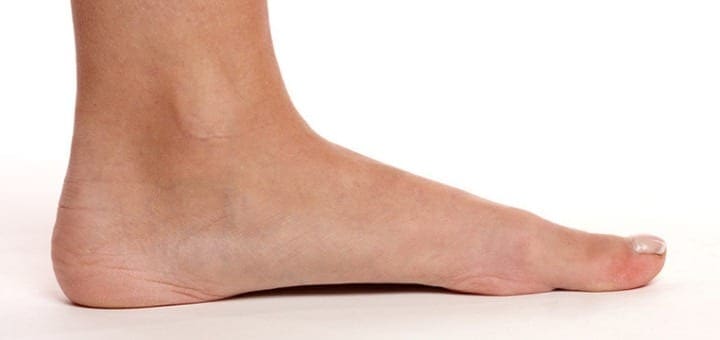
In children, it’s often common to notice that a toddler or a baby has flat feet when they’re walking. However, it’s hardly a cause for alarm. It is actually normal for a child to have flat feet because the bones—especially the ones in their feet—are still developing. In adults, though, it’s a different story. At an adult’s age, you’re typically finished with growing and developing, which will mean that if you have flat feet at that point, it isn’t simply going to go away.
Let’s back up, however, and define what flat feet are and what it looks like.“Flat-footed”, “flat feet”, and “fallen arches” are nicknames for Pes Planus, which, when found in adults can be defined as a postural deformity where there is no arch in the foot and the whole sole of the foot touches the ground.
Even though it also isn’t a cause for alarm to have Pes Planus as an adult because you probably have had this condition since you were a child, you still need to be careful with your feet in the future. Those who have flat feet are often more at risk for foot injuries than those who have a normal arch.
If you think you have flat feet because of these symptoms, you might want to check with a foot doctor before “diagnosing” yourself. Here are some symptoms:
- When walking, your feet get easily tired.
- On your soles, the middle parts of your feet are swollen.
- Your feet get easily sore—especially the soles and heels.
Causes of flat feet
Especially since they are seen often in children, you might be wondering what causes flat feet. It’s not always based on the same reason and one case can differ greatly from another. Here are a couple of causes as to why your feet—or those of your children are flat:
- It is a genetic birth defect. The child is simply born with flat feet.
- The posterior tibial tendon may be inflamed or damaged.
- The bones or capillaries in the foot may be disjointed or damaged.
- The foot tendons or ligaments may be over-stretched.
- They even may be caused by rheumatism or arthritis.
People at risk of flat feet
Even though it can be defined as a genetic defect, people also might develop flat feet later on simply by their behavior or their lifestyle. You are at risk of developing flat feet if you:
- Are obese or heavily overweight
- Are older and do not walk often
- Wear inappropriate or uncomfortable footwear often
- Have improper foot and lower limb posture or movements.
If it seems like you have flat feet, you are not alone. This Pes Planus affects 20 percent of the general population. However, just because there are others with you, doesn’t mean you shouldn’t do everything you can to correct here.
Unfortunately, having flat feet can put you more at risk for lower back pain and discomfort, among other things. Flat feet can lead to other conditions and deformities in the body like:
- Lower back and knee pain: Since you’re not able to absorb the shock as much as you normally should, this lands all that weight and pressure onto other joints—like the knees and the back in particular.
- Deformities in your foot: Since your feet will be taking most of the weight onto those non-existent arches, bunions and hammertoes may develop.
- Develop plantar fasciitis: Unable to absorb shock, the fascia that runs along the bottom of your foot can become inflamed.
Treatments for Flat Feet
Although there really isn’t a flat-foot cure because it often is not an issue, people with flat feet may feel pain after walking or exercising. In these cases, there are some treatments that you can do after contacting your podiatrist.
They may have you participating in some of these treatments:
- You may receive a casting or bracing of the foot to help with the arch.
- You may also be recommended to wear a specific type of footwear.
- You may be sent or mandated to practice foot-specific physical therapy.
- You may just be shown some foot exercises and stretching to help alleviate the pain.
- In heavy cases, you may be prescribed medication to relieve inflammation
- In the worst cases, you might have to undergo surgery.
Before you get to the doctor, however, there are a few things that you can try out to see if the pain improves upon self-treatment. Not every case has to go to a doctor—however, we do recommend it. If you’re willing to give it a try at home, here are a few “treatments” you can try to alleviate flat feet pain:
- Leave your high heels at home: There are certain times where you can dress up and wear high heels, but try and avoid it! Wearing high heels will forces the weight to the front of your foot. That imbalance can cause some foot abnormalities, like bunions and clawed toes. You’re not helping your case risking even more issues in your feet!
- Try quality orthotics: Even though it always helps to ask your personal doctor about the specific orthotics you need, normally a great shoe store can help you out. Quality orthotics will give you proper arch support for your feet and help you distribute your weight in a better way so your body is absorbing the shocks much better and more properly.
- Get that BMI down: It’s possible that the reason your feet hurt so much is a little extra weight pushing down on them. Obesity is a huge risk factor for flat feet, along with a whole mess of other health issues. Being healthy should be priority number one!
- Over-the-counter gels: Even though it won’t help from the inside-out, it will temporarily soothe that joint or muscle inflammation.
Nothing, however, will beat out going to a podiatrist and getting your feet checked out. Especially if you are concerned with some new pain, you might want to get professional to look at your feet before you take on any kind of treatment—who knows, your problem might be elsewhere or be bigger than you think!

